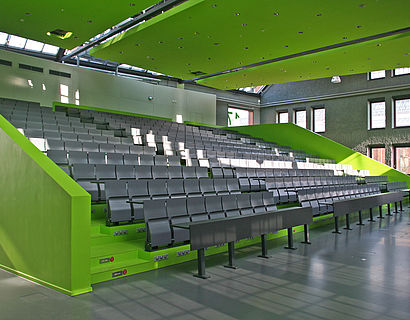
Juja Chakarova (Dipl. Eng., Head of Library, Max Planck Institute Luxembourg for Procedural Law, Luxembourg) & Johannes Trabert (Dr. Eng., Executive Partner, MetraLabs GmbH, Germany)
I Robot can help you Librarian
Modern librarians are called to become information and knowledge managers, however they are also requested to deal with a lot of routine tasks, like labeling, shelving, doing inventory. Shouldn’t we delegate these repetitive assignments to robots and save our time for more important missions? Will many of our tasks be taken by ‘increasingly capable machines’, as predicted by prof. Richard Susskind in his book “The Future of the Professions”?
Since the 1980s we witnessed libraries to continuously ceding their traditional territories. Machine-readable catalogues replaced the card catalogues in the 80s, the Internet enabled the online public access catalogue (OPAC) in the 90s, while the RFID allowed in the 2000s borrowing, returning and sorting library items even in the absence of a librarian. Libraries embrace technology to offer better, faster and continuous services to their users.
The Library of the Max Planck Institute (MPI) Luxembourg for Procedural Law explores the present and future use of robots in libraries. In 2016 the Library tested the Tory robot, MetraLabs Germany, to make an inventory. In only one hour the RFID tags of 35,000 books were read by Tory with an accuracy of 99,11%. The methodology and results will be presented, followed by a live demonstration of the new Tory model.
The presentation will discuss new areas of robot implementation in libraries. In addition, the results of the ‘Robots in Libraries’ survey 2018 will be discussed. The survey was conducted on 2018 among big university and public libraries in 9 European countries. It gives a snapshot of the current robot implementation, the future expectations and concerns of the librarians.
With the introduction of robots, library staff will be relieved of certain repetitive tasks and as a result will have more time to get to know their users and to devote themselves to service-oriented work.

Takashi Harada (Professor, Doshisha University, Japan)
Robotics and artificial intelligence technology in Japanese libraries
Robotics and artificial intelligence technology are rapidly spreading in libraries. Conventionally, libraries have used an auto book circulation system or automated storage and retrieval system (ASRS) both with automatic control technology and IC tags. In recent years, robots have been used in various other places in Japanese libraries. A guiding humanoid robot is a typical example. The humanoid robot Pepper developed by Softbank is already active in dozens of libraries, and there are plans to introduce 500 or more. As a guiding robot, animal type robots such as a rabbit are also used.
In addition, there are many robots that work behind the scenes in libraries. For example, an auto-tracking booktrack makes it possible for a librarian to perform return processing without having to operate a heavy booktrack. The robot suit HAL (Hybrid Assistive Limb), which was developed at the University of Tsukuba, assists lifting work and reduces the burden on the waist. The Tsukuba Central Library uses HAL to lift heavy bookcases onto a bookmobile.
Furthermore, artificial intelligence technology is being used for reading assistance and programming classes in libraries. The game "KOKORO" Saver, which we developed, has a mechanism to recommend children's books according to their interests. Kinki University library analyzes the content posted on social networking sites (SNSs) and introduces books that match the potential interests of the student. Although the use of robots in the library is still developing, it is expected that robots will be used more and more in the library.

Bohyun Kim (CTO & Associate Professor, University of Rhode Island Libraries, USA)
AI-Powered Robots for Libraries: Exploratory Questions
With the rapid developments in machine learning, a subfield of artificial intelligence, it seems no longer extraordinary to think that we will be soon living in the world with many robots around us. While the term ‘robots’ conjure up the image of a humanoid machine, robots can take many forms ranging from a drone, an autonomous vehicle, to a therapeutic baby seal-bot. What kind of robots should we expect to see at libraries?
Another interesting question regarding robots and libraries how we will be interacting with those robots once they came to be in the world with us. Even though a robot has no consciousness, humans have a strong tendency to anthropomorphize a variety of objects they interact with. A robot is embodied, autonomous, and intelligent. For this reason, humans are even more susceptible to attribute motives, emotions, and other human traits to robots. If robots are involved in our information-seeking activities, what kind of human-robot relationship would facilitate or impede those activities?
This paper will explore three topics: (1) what kind of robots we may expect to see at libraries in the future; (2) what kind of human-robot relationship may be formed in people’s information-seeking activities; (3) what ethical and social issues may arise from the new human-robot relationship. I will also touch on interesting questions such as how a library robot should be engineered, what kind of settings it must have, and what the ultimate goal of a library robot may be.

Lynn Kleinveldt (Dr., Faculty Librarian (Applied Sciences and Health & Wellness Sciences) & Lecturer at Cape Peninsula University of Technology Libraries, South Africa)
Roving with telepresence robots: A faculty librarian experience
Technology is the main driver of change which is apparent in the ‘library as space and place’ phenomenon today. Since library physical spaces have already been transformed, revamped into technology-rich spaces or hubs, opens up an opportunity to expand on reference services. To remain relevant and avoid becoming ‘useless’ in the 4th Industrial Revolution, it is fundamental for librarians to embrace emerging technologies to provide state of the art library and information services. Although the “call centre model”, providing a 24-hour virtual reference service has been a practice for some time among academic libraries in different parts of the world, there is still a need to
facilitate social interaction between librarians and students in the physical library especially after-hours. Therefore collaboration between various stakeholders is key in moving towards a dynamic learning environment. The question is, how do librarians deal with research trends in the 21st century to ensure that all the information and research needs of the university community are met? Is it time to consider adding telepresence robots to our library staff complement? This paper reports on a South African faculty librarian’s experience on participating in an international collaborative pilot project between a university library in the US and the Department of Philosophy and Communication at a University in Italy, to test remote access and control of a telepresence robot to boost current reference and research support services. It is hoped that this experience will give insight into how academic libraries can take reference and research support services to another level, through telepresence robots.

Yi Chin Liau (Head of Innovation and Digital Media, National Library Board Singapore, Singapore)
Transforming library operation with robotics
At Singapore public libraries, robots and automatic sorting machines are used to help staff and volunteers with sorting returned books, shelf reading and transportation of library materials. The National Library Board (NLB) has embarked on its robotics journey in 2013 with the introduction of autosorter at the library@Chinatown. Since then, NLB has leveraged on technologies and robotics to re-engineer its library operations and automate many of the labour-intensive and time-consuming tasks.
The paper shares how the adoption of robotics and automation technologies has transformed the library operation and improved customer experience at the libraries.
The initiatives include
- Autosorters that automatically sort returned books by categories as well as identifying popular titles to be placed at “Just Returned” shelves.
- Shelfreading robot that autonomously scans the book shelves after the library closes and provides upto-date shelf location of books and flags out misplaced books.
- Mobile Bookdrop that autonomously transports the returned books to the backroom
Process re-design is crucial to the successful adoption of robotics. NLB conducted a business-process re-engineering (BPR) exercise to review its shelving operations and adopted a proof-of-concept approach to test out the proposed workflow and process changes against initial prototypes. Extensive trials were also conducted with the library staff to address operation concerns and to ensure a smooth change transition.
These innovations have helped to achieve cost savings and simplified workflow for the aging workforce, in addition to bringing convenience to citizens. The operation staff can now take on other higher-value tasks such as engaging patrons and conducting library programmes. Moving forward, NLB will be exploring the use of service robots such as chatbots to provide more timely and responsive services to library users.

Elfriede Ludwig (Librarian & Head of Digital-Services-Team at the Public Library of Frankfurt am Main, Germany)
What are the robots doing at the Public Library of Frankfurt?
NAO, DoBot, Dash and Dot - a whole variety of robots will move into the Public Library of Frankfurt. Early August will be the kick-off for the “Robot-Invasion”. The reason behind this is the project “Robotics and Coding” in cooperation with the staff unit Digitization. This broad-based digitization project is part of the evolving strategy that initially started with the formation of the “Digital-Services-Team”.
Robotics & Coding - while Dash, Dot and co. shall playfully arouse the interest of children and adolescents, DoBot teaches young people and young adults how robots function in the industry, and NAO explains to our patrons how the Public Library works.
We will report on the first experiences we gained with the different formats from our event series in August (just before the IFLA satellite conference - so very up to date).
Our presentation includes the project-preparation, procurement of the infrastructure, the concept, the involvement of our patrons, the perspective of the employees and cooperation partners, the marketing efforts and our experiences with the opening week.
Philipp Müller (M.Eng., Technische Hochschule Wildau — University of Applied Sciences, RoboticLab Telematics, Germany)
Human-Machine-Communication based on Natural Language Processing: Using a humanoid robot in the context of a university library
How to present and access contents in an appropriate and modern way related to a university library – that is what Technical University of Applied Sciences Wildau (TH Wildau) is dealing with lately. After buying the humanoid robot „Pepper“ in late 2016 everything is aligned to a Human-Machine-Interface approach, in which the robot is supposed to work as an assistance system to meet the end-user needs and answer contextual questions. Consequently, Pepper has to become a librarian that knows the library itself, available services and media contents inside out.
Our vision and the expectations towards a humanoid robot, whose perception is humanized, leads to the task of providing a functionally suitable way for communication purposes. That is why we set the focus on natural language and how to process human speech to detect intents and entities related to our library and how to provide a conversational style in a dialog between the robot and humans.
Processing speech by robots – or more general, computers – is called Natural Language Processing (NLP). In the world of technology NLP is not considered something new and the history of it actually started in the 1950s. Yet, recent products like Amazon Alexa (Smart Speakers) or Google Duplex (Smart Assistants) are heavily relying on NLP and therefore pushing it to new levels. However, using the underlying software for custom projects is often very expensive or not allowed at all. Luckily, the open source community profits as well because more and more developers are entering this field of software development.
The presentation will show you what free-to-use and open source projects can achieve when combining them to a full-featured NLP application consisting of speech recognition, speech to text, natural language understanding, natural language generation and text-to-speech.

Samuel Oladunjoye Odeyemi (Doctoral Student, Information Studies, University of KwaZulu-Natal, Pietermaritzburg, South Africa)
Robots in Nigerian academic libraries: Investigating infrastructural readiness and potential for library services
The purpose of this study is to investigate the infrastructural readiness of Nigerian academic libraries in deploying robots and its potential for the provision of library services. This study is motivated by the fact that Robot as a machine which performs automatic set of tasks are gradually gaining entrance into libraries in the developed world. It was observed that Nigeria as a developing country are leapfrogging to embrace the emerging fields such as The Industry 4.0. This has to do with the current and developing environment in which disruptive technologies and trends such as Robotics are having a huge impact changing the way we live and work.
The further focus of the study is to use the lens Robotics and related strands such as Artificial Intelligence (AI) in the adopted libraries to view how ready the selected Nigerian universities libraries vis-a-vis their LIS?ICT professionals on potential of the technologies. The study will adopt the post-positivist paradigm and a survey research design using observation and semi-structured interview for a focused group. The observation checklist will be utilised to collect data to guide on infrastructural readiness of the libraries, while the interview schedule will be used to elicit qualitative data from five members of 3 set group of librarians/ICT professionals on potential of robots deployment in their libraries. Purposive sampling will be used to select five members from each of the universities. Three academic libraries will be purposively selected based on ownership (federal, state and private), namely: Federal University Oye-Ekiti, Ekiti State University and Afe Babalola University to form the site of the study. The quantitative data collected through the use of checklists and qualitative data from the engaged group will be analysed using content, narrative and discourse for new data to emerge as findings.

Gabriel Recatala (Ph.D., Associate Professor at the Jaume I University, Spain)
The UJI Librarian Robot Revisited
Some years ago, in the context of a project titled "the UJI librarian robot", the UJI Robotic Intelligence Lab developed a robotic mobile manipulator that was able to autonomously locate a book in an ordinary library, and grasp it from a bookshelf, by using eye-in-hand stereo vision and force sensing. The robot was composed of a robot arm mounted on top of a mobile vehicle, and was only provided with the book code, a library map and some knowledge about its logical structure. The system took advantage of the spatio-temporal constraints and regularities of the library environment by applying disparate techniques such as stereo vision, visual tracking, probabilistic matching, optical character recognition, motion estimation, multisensor-based grasping, visual servoing and hybrid control, in such a way that it exhibited a robust and dependable performance. The system was tested, and experimental results showed how it was able to robustly locate and grasp a book in a reasonable time without human intervention.
A second version of the system was developed later enhancing the robot capabilities by replacing the parallel-jaw gripper with a three-finger hand, so that book extraction was just one among many possible manipulation skills.
The purpose of our contribution to the IFLA WLIC Preconference Satellite Meeting on Robots in Libraries: Challenge or Opportunity? is to present and review the project with experts in technology for libraries, to discuss new opportunities, pros and cons, for the actual deployment of these systems, steps towards improving them in the context of state-of-the-art technology and current developments for cyber-physical systems, present related projects such as UAV (drones) for automatic inventory duties, or the use of Internet of Things and RFID tags.

Zhengwei Xia (Associate Research Librarian and Head of Library Systems, Wuhan University, China), Quan Li (General Librarian, Wuhan University, China), Wenhui Duan (Assistant General Librarian, Wuhan University, China) & Ping Fu (Professor and Head of Library Technology Services, Central Washington University, USA)
A Post-implementation Review Analysis for an Autonomous RFID Inventory Project: A Qualitative Study
The purpose of the study is to use the results of a post-implementation review analysis for an autonomous RFID inventory project in Wuhan University Library to examine three hypotheses: the RFID locating function can help end users to find books more quickly (Hypothesis 1); the RFID robot system improves inventory work efficiency (Hypothesis 2), and; the RFID robot system improves inventory accuracy (Hypothesis 3), and make recommendations to areas for improvement identified through the review. A qualitative research method is primarily employed for the study. Two surveys are designed for collecting data and gaining information and insights from a predefined group of respondents. A research interview is also conducted with the library dean and associate dean for technology for seeking feedback and insights from library administrators. Additionally, two experiments are designed for measuring inventory accuracy and scanning and locating accuracy. The results of the analysis and experiments positively supported the three hypotheses. Finally, the study proposed some recommendations to areas for improvement such as enhancing locating algorithm; ensuring network connected; migrating location calculation to a local server; providing more training to library staff and patrons, and; promoting the locating function to patrons.

